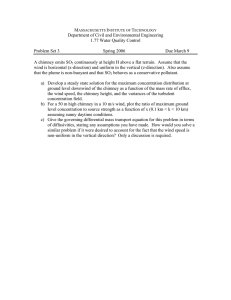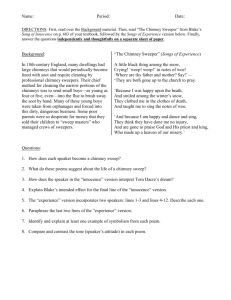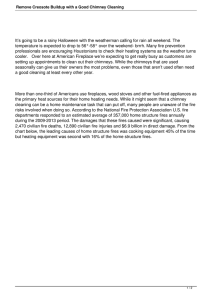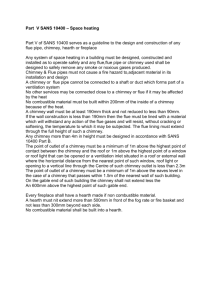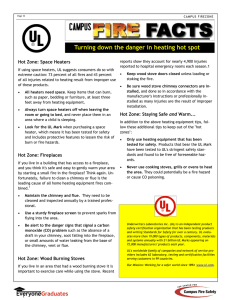chimneyfires Jan03 2018
advertisement
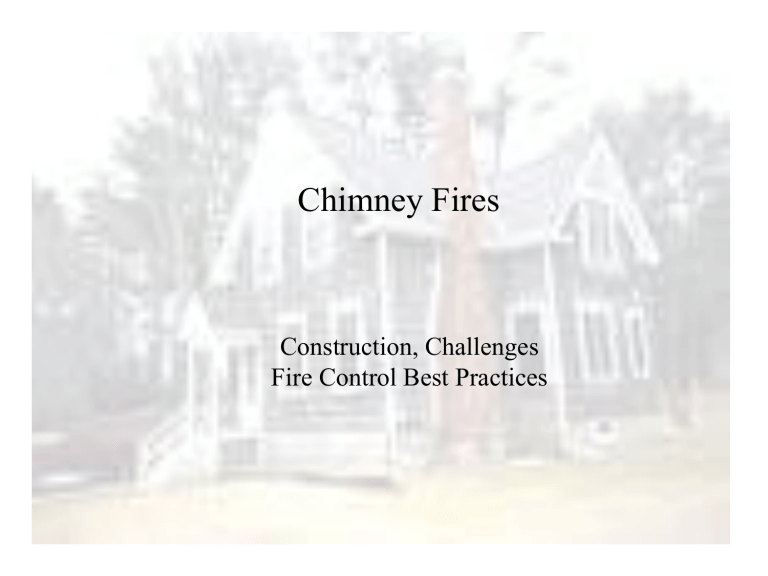
Chimney Fires Chimney Fires Construction, Challenges Fire Control Best Practices Objectives • Review different types of chimney construction • Identifying lined vs. unlined flues • Understand fire spread characteristics of most common chimney types • Effective fire control practices Chimney Construction • The chimney method of smoke removal has been around for centuries. • All chimneys are essentially manufactured in a similar fashion. The by-products of the fire exit upward by convection through the chimney flue. • Early man discovered the benefits of vertical draft methods in removing smoke from caves, huts, etc. Chimney Construction (cont.) • Various means to construct vertical drafts (chimneys) used: – – – – – Stone Mud/sticks Hollow logs Bricks Metal (modern) Attachment Methods • • • • • Interlock wall stones with chimney stone Free-standing Wall logs interlocked in stone or brick Metal ties to wall framing (20th century) Metal bracing within wood framework (modern zero-clearance chimney piping) Attachment Methods (cont.) Attachment Methods (cont.) Lined Flue • Inside of chimney construction contains flue “pipe” or “lining” that minimizes openings, joints, or crevices along vertical path of heat, smoke, embers Metal Chimney Liner Tile Chimney Liner Liner Characteristics… • Each type of liner has it’s benefits and drawbacks… – Metal is expensive, but crack resistant and often installed in one piece top-to-bottom. – Most common sizes are 6- and 8- inch – Easy connection to wood/coal stoves – Can be routed through some twists and turns – Can retrofit old, unlined flues Liner Characteristics (cont.) • Tile, or terra cotta, offer wider passages than metal and are less expensive than metal • Not used in retrofits or relining of existing flues • Susceptible to temperature extremes and settling of foundations, causing cracking • May consist of several joints Zero-Clearance or Prefabricated Metal Chimney Flues • Developed nearly 25 years ago to service the growing alternative heating market • Consist of multiple layers of stainless steel separated by fireretardant insulation Unlined Flues • Found in many homes built prior to 1930 • May be of stone or brick construction Unlined Flues (cont.) Fire Spread Characteristics Tile/Terra Cotta Liners • Cracks appearing over time and temperature extremes provide openings for hot ash/embers to exit the flue and contact adjacent combustible framing members • May also provide path into void spaces, carrying sparks into area containing combustibles (attic, behind knee wall) Terra Cotta/Tile Liner (cont.) • Subject to degradation from rain, ice, snow • Mechanical damage from improper cleaning, previous fires • Damage introduced from exterior forces (wind, trees) Metal Chimney Liners • May warp from extremes in temperature (burning stove too hot) • Improper attachment of flue sections Metal Flues (cont.) • Joints may be open, allowing sparks and embers to escape into void and combustible spaces adjacent to chimney, permitting fire spread and slow detection of same. • Stainless steel tubular liners are used in older unlined retrofitting, often resulting in turns and twists permitting build up of creosote and animal nests. Creosote Buildup • Creosote is a byproduct of INCOMPLETE combustion. • Adheres to tile, unlined, flexible metal, and joints in flue liners Creosote (cont.) • Relatively cool temperatures in upper portion of flue condense products of combustion into potential “time bombs” on liners. • Can be minimized by burning proper fuels (seasoned wood) at proper temperature recommended by stove/fireplace manufacturer • Creosote is black or brown in appearance with a crusty or flaky consistency. It can be tarry, drippy and sticky or shiny and hardened. • Regardless of the physical presentation of the creosote, it is highly combustible. If the build-up of the volume of creosote is sufficient, it is possible to start a chimney fire. Animal Nest in Chimney Flue Retrofitting Unlined Flues • It is common to find older, unlined chimneys outfitted with new style flexible, stainless steel tubular liners • Often connect to wood stove or insert • May be placed in unlined flue surrounded by fire-resistant material such as a vermiculite/gypsum mix Prefabricated Metal Chimneys • Have Class “A” fire rating and may be used inside of wooden box framing according to building codes and Underwriter’s Laboratories test results • Lock together in a twisting motion • Are NOT fire PROOF!!! Identifying Fire Presence and Control Options Caller Complaints • Hear persistent “roaring” sound from upper flue area • Smoke from chimney when no active fire in fireplace/ stove • Haze/smoke odor in upper floors of house and/or attic • Walls adjacent to chimney hot to touch Chimney Fire Size-Up • Burn explosively • And are generally noisy and dramatic enough to be detected by neighbors or passersby. • Victims of them compare the sound of the fire to a low rumbling noise like a freight train or low-flying airplane. • Flames have been known to shoot from the top of the chimney accompanied by dense smoke. • The first indication of a chimney fire is usually the noise — a roaring sound that grows louder as the fire intensifies, reaching temperatures of up to 2,000 F. Chimney Fire Size-Up (cont.) • Not all chimney fires are visible from the exterior. Some are slow-burning fires, lacking the levels of air or fuel found in the large, eye-catching visible fires. • The volume of fire, smoke and heat from this type of fire can push hot gases out of existing cracks in the chimney mortar or cause internal connectors to fail. When viewed from the exterior, large smoke volume and sparks and fire can extend several feet above the chimney. Video Video to Demonstrate the rapid rate and damage of a chimney fire on Terra Cotta and Metal flues and liners. https://youtu.be/4gfAEsSTB7c Video to demonstrate damage to an older home. (Show only a short version.) https://www.youtube.com/watch?v=mUzYXddccgc Examples of Damage https://www.bing.com/videos/search?q=chimney+fire&&view=detail&mid=52B1 C95ED2AA7EB5785A52B1C95ED2AA7EB5785A&&FORM=VRDGAR Fire Department Dispatch https://www.bing.com/videos/search?q=Fire+department+dispatched+to+a+chimn ey+fire&&view=detail&mid=CCDD1E9BC4F29A720ABDCCDD1E9BC4F29A7 20ABD&&FORM=VRDGAR Safe Use of a Tower or Ladder Truck https://www.bing.com/videos/search?q=Fire+department+dispatched+to+a+chimn ey+fire&&view=detail&mid=07F511E480F500BC5F6E07F511E480F500BC5F6 E&&FORM=VRDGAR Fire Control Tactics • Chimney fires should be dispatched as a full-structural response until the size, location and access impacts are assessed. • Ensure the occupancy is fully evacuated. And because all fires are unpredictable, firefighters must wear full PPE, including SCBA. • Stretch a preconnect line to the front of the structure in case the fire is larger than initially anticipated. • Chimney fires rarely occur when the weather is good, so watch your footing in wet and/or freezing-rain conditions when accessing the roof. • Thermal Imager A MUST!!!! – Demonstrate the imager from 801 • Get personnel ABOVE and BELOW fireplace/stove-check walls, floor space adjacent to flue—attic • Check flue clean out (if present) • Roof crew to check openings at top Tactics (cont.) • Remove active fire from firebox – Review Tools from 801 for performing this procedure. – Maximize your customer service skills by using floor runners and fire-retardant salvage covers near the fireplace during salvage and overhaul. Careful cleanup can earn your department valuable praise from the homeowners • Closely monitor flue for active flames – Visually inspect the chimney with a mirror to determine the extent of the fire. • If the fire is contained within the flue system, move on to chimney fire-specific extinguishment methods. – Consider use of dry chemical extinguisher or “chimney bombs” (dry chem in plastic baggies dropped from top of chimney) • Pressurized water extinguisher and/or preconnect should be LAST RESORT on the chimney fire or fireplace. • Send a recon team directly to the attic and make sure that the fire has not extended into this space or the cockloft. Inspect the firebox itself and as much of the chimney in the inside of the home as possible. Tactics (cont.) • Once fire controlled, occupant must be directed to have licensed chimney sweep clean and inspect chimney PRIOR to ANY additional usage. • Officer should document this on NFIRS report. Points to Consider… • Successful control of chimney fires requires time and patience • Continual monitoring of all adjacent combustible areas required during operations • Older, unlined flues often contain structural framing members tying chimney to house Other Important Considerations… • EARLY laddering of roof • Use of chimney chains to clear flaming creosote (if available on scene) • Aggressive investigation of adjacent void spaces • Identification of lined vs. unlined flue Summary • Firefighters should be familiar with the various chimney types • Understand particular hazards of each type of flue • Recognize signs of active fire situations in flue and execute proper control methods Summary (cont.) • Make every attempt to control fire while minimizing damage to chimney/flue structure • Ensure safe operations when working in poor lighting and on wet/icy or steep roof pitches
